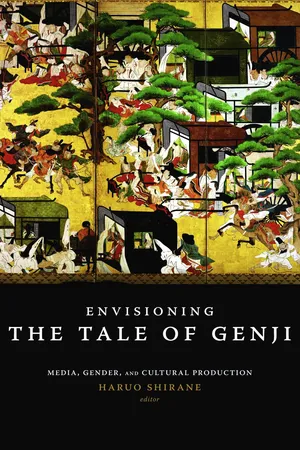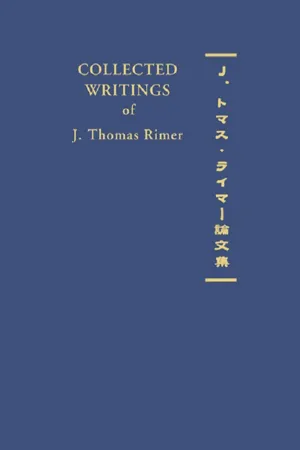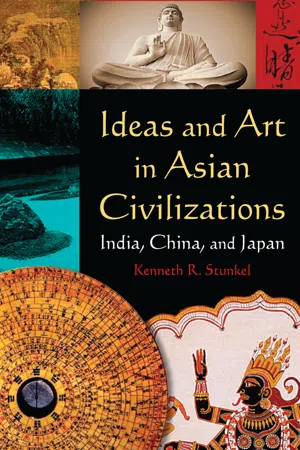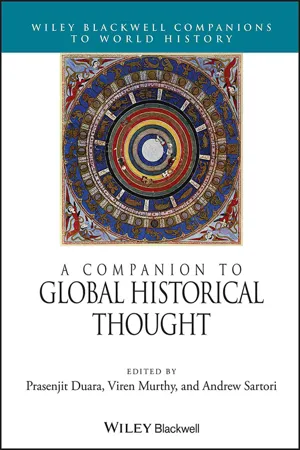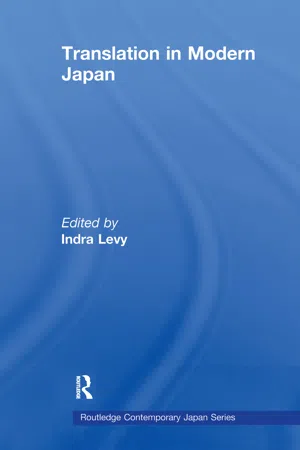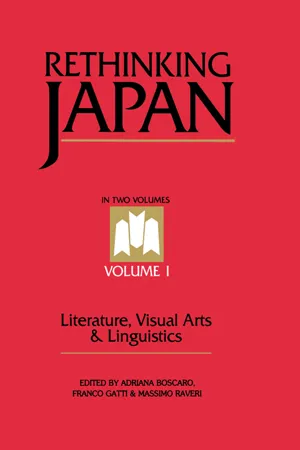History
The Tale of Genji
"The Tale of Genji" is a classic work of Japanese literature written by Murasaki Shikibu in the early 11th century. It follows the life and romantic exploits of Hikaru Genji, a nobleman and courtier, and provides a vivid portrayal of the Heian period in Japan. The novel is celebrated for its intricate narrative, rich character development, and exploration of themes such as love, loss, and the passage of time.
Written by Perlego with AI-assistance
Related key terms
Related key terms
1 of 4
Related key terms
1 of 3
8 Key excerpts on "The Tale of Genji"
- eBook - ePub
A History of Japanese Literature
From the Manyoshu to Modern Times
- Shuichi Kato, Don Sanderson(Authors)
- 2013(Publication Date)
- Routledge(Publisher)
By skilful disposition of a comparatively limited vocabulary they refined their own distinctive rhetorical style. Living as they did in a world where everyone was acquainted, they wrote about the life of that world and created a special form of literature in which, for all intents and purposes, the writer was the reader and the reader could identify with the characters. This, however, did not mean that there was none among them capable of writing a work which would transcend the particular time and place; indeed it was one of their number who wrote The Tale of Genji. The Tale of Genji The Tale of Genji, with fifty-four chapters the first long tale after The Tale of a Hollow Tree, was written by the Lady Murasaki early in the eleventh century, although the precise date of composition is unknown and the authorship of at least part of the book is disputed. The bulk of the novel (the first forty chapters) deals, broadly speaking, with the career and, in particular, amorous adventures at court of the idealized hero of the tale, the 'Shining' Prince Genji. it begins with a love affair between Genji and his step-mother Lady Fujitsubo (in the section called Wakamurasaki) and ends with adultery between his wife Onna San-no-miya and Kashiwagi (Wakana) and the death of Genji's other wife Murasaki (Minori). Between these, Genji's promotion at court, his exile (Sutna and Akashi) and return are described. The final thirteen chapters follow the fortunes of the characters surviving after Genji's abrupt death, though his death itself is not described in the novel, centring on the 'triangular' relationship between Kaoru (the child of Genji's wife and Kashiwagi, the son of Genji's best friend, Tō no Chūjo), Prince Niou (Genji's grandson) and the beautiful girl Ukifune - eBook - ePub
Envisioning The Tale of Genji
Media, Gender, and Cultural Production
- Haruo Shirane(Author)
- 2008(Publication Date)
- Columbia University Press(Publisher)
Genji was adopted in all secondary-school textbooks (and in the state-compiled primary-school textbooks from 1938), and the tale became popularized through several translations into modern Japanese.THE NOVEL AS THE REFLECTION OF THE LEVEL OF CIVILIZATIONThis chapter examines the critical discourse that emerged around The Tale of Genji from the 1880s to the 1930s in relation to the emerging field of modern Japanese literature and the construction of national literature. The Tale of Genji played a significant role not only in the construction of national literature and national language but in the formation of modernist literary discourse in Japan. In Japan, the discourse of modernism—which emerged in Europe as a counter-discourse to bourgeois industrial modernity—actively contributed to the articulation of national cultural identity.The Tale of Genji was first translated into English in an abridged version (seventeen early chapters) by Suematsu Kenchō (1855–1920), who lived in En gland from 1878 to 1886, initially as a secretary to the Japanese legation in London and then as a student of law and literature at Cambridge University. In translating the Genji into English, Suematsu apparently attempted to demonstrate that Japan had a sophisticated masterpiece of “native literature” that could provide the European audience with “information on the history of the social and political condition of [his] native country nearly a thousand years ago”—an ancient civilization that, he proudly suggested, could be compared favorably with the culture of medieval and modern Europe.1 - eBook - ePub
- J. Thomas Rimer(Author)
- 2004(Publication Date)
- Routledge(Publisher)
For the Chinese of the classical period, poetry and the essay represented the art of the gentleman; stories and tales were worthy only of the marketplace. There were many reasons for such attitudes in China, some of them involving the distance between the classical and spoken languages, some due to certain Confucian pieties. Suffice to say that when the Japanese unwittingly absorbed some of these prejudices, they did so without a full understanding of the Chinese background. Indeed, had they absorbed those attitudes more fully, there might well have been no Tale of Genji for us to read. Fiction, however, had its powerful defenders. One of the best places to see these tensions at work is in the text of Genji itself. It is clear from the conversations among the various characters in the novel that many in the Heian court read fictional narratives with great enthusiasm. A number of titles of stories and tales are mentioned in these discussions; now lost, they were obviously once staples. In a long and celebrated discussion over the merits of fiction, Prince Genji himself defends the art of the imagination. The conversation he holds with his ward Tamakatsura is far too long to reproduce here, but the following extract is telling: He smiled and went on: ‘But I have a theory of my own a bout what this art of the novel is, and hou’ it came into being. To begin with, it does not simply consist in the author's telling a story about the adventures of some other person. On the contrary, it happens because the storyteller's own experience of men and things, whether for good or ill—not only what he had passed through himself but even events which he has only witnessed or been told of—has moved him to an emotion so passionate that he can no longer keep it shut up in his heart. Again and again something in his own life or in that around him will seem to the writer so important that he cannot bear to let it pass into oblivion - eBook - ePub
Ideas and Art in Asian Civilizations
India, China and Japan
- Kenneth R. Stunkel(Author)
- 2015(Publication Date)
- Routledge(Publisher)
6It is known that Murasaki married in about 999, had a daughter, was widowed in 1001, wrote the novel between 1010 and 1020, and died at about age fifty. Apparently part of the work was composed near Uji at Byodo-in, an aristocrat’s elegant villa before it became a temple of light dedicated to Amida Buddha (fig. 22.1 ). The novel reveals that Murasaki was intimately knowledgeable and wise about court life, personalities, and intrigues of her time. One learns a great deal about the pecking order in Heian society, the intricacies of kinship, and the demanding minutiae of court protocol.Insulated from the countryside, she had little regard for anything going on outside of Kyoto, but within those limitations, her psychological astuteness and aesthetic sensitivity are impressive. Her world was small and confined, but she captures its structure and movement with verve, eloquence, and intelligence. She was well educated in Japanese and Chinese literature, both poetry and history. Japanese taste for allusiveness and suggestion is expressed in Genji by hundreds of short poems, some original, others from previous famous collections of poetry, notably Man’yoshu in Japanese and Kokinshu in Chinese.The novel spans three-quarters of a century. Its chief subject and hero is the “shining prince,” Genji, whose amorous adventures and relationships are detailed in forty-one chapters. The last ten chapters, written in the village of Uji (the word means “forlorn”), deal with his ostensible son, and the final chapter, “The Floating Bridge of Dreams,” suggests that Murasaki intended to continue the novel along different lines and with a different theme. In other words, there is no conclusion. - eBook - ePub
- Prasenjit Duara, Viren Murthy, Andrew Sartori(Authors)
- 2014(Publication Date)
- Wiley-Blackwell(Publisher)
The Tale of Genji “reveals human intentions and plumbs the depths of human feelings” (19):But because we are unaccustomed to elegant words, our prose is nearer to the vulgar. As we are creatures of the countryside, we aren’t well versed in the fashionable expressions of the city. Fortunately, this means that this work won’t resemble those kabuki books. (20)As this suggests, Teishō’s choice is to abjure exclusive reliance on any one style. His style combines everyday language with prose patterned after military tales and the classics. He incorporates vocabulary from the original Chinese stories, so that at times his prose reads as if it were translated straight from the Chinese.For his part, Akinari acknowledges two exemplars in his preface to Ugetsu monogatari : Murasaki Shikibu, author of the Tale of Genji , and Luo Guanzhong, author of great Chinese novel, Water Margin. “We see in their works an abundance of strange and wondrous things,” he writes. “The force of their words draws near the truth; . . . they make us see the reality of the distant past.” That the past was, in reality, “strange and wondrous” seems of a piece with the insistence in his exchanges with Norinaga that the past belonged to a separate realm. Of course, inUgetsu he reinforces this sense of our estrangement from the past by populating it with ghosts. But the combinations that he foregrounds here – prose styles as distant from readers today as those of Genji and Water Margin, strange and wondrous things, and the reality of the past – are also interesting because they indicate that he was seeking a way of expressing our distance from the past, while yet maintaining that it was real, that it was something that could be comprehended.An excursus on Western historical fiction might be helpful here. The dedicatory epistle to the historian and antiquarian, the Rev. Dr Dryasdust, that prefaces Walter Scott’s Ivanhoe , comments on the language used to communicate the historical world in which Ivanhoe - eBook - ePub
- Indra Levy(Author)
- 2017(Publication Date)
- Routledge(Publisher)
movements of the mid-1920s to early 1930s, and were inspired by the artistic creations and theoretical formulations of the European avant-garde. 50 This linking of The Tale of Genji with the highly experimental literature of a group of young writers, then in their late twenties and early thirties, functioned, needless to say, as a declaration of Genji ’s relevance to the present, a recasting of the tale as an ancient work whose literary sensibility was somehow new – not merely modern, but contemporary. Presumably this sense of Genji ’s “newness” and potential relevance to readers must have figured in the savvy businessman Shimanaka’s decision to push Tanizaki to translate the tale. He had the acumen to see that Genji monogatari translated by Tanizaki could be the next big thing. But we might also consider Hakuchō’s linking of the classic and the cutting-edge in another light. At the same time that Hakuchō is pointing to Genji ’s newness and potential relevance, he is also holding out the possibility that the young writers on the cutting edge might one day be able to discover an echo of their “New Sensibility” in Japanese tradition, and thus that they themselves might eventually be reinscribed into a tradition reconnected to contemporary Japan by the passage of its classical texts through translation into the canon of world literature. In effect, Hakuchō was opening the door to a reconciliation of the avant-garde with the traditional. This reinscription, this reconciliation is precisely what the Nobel Prize committee achieved for Kawabata when it recognized “his narrative mastery, which with great sensibility expresses the essence of the Japanese mind” in 1968 - eBook - ePub
Rethinking Japan Vol 1.
Literature, Visual Arts & Linguistics
- Adriana Boscaro, Franco Gatti, Massimo Raveri(Authors)
- 2014(Publication Date)
- Routledge(Publisher)
miyako – the space created by man. In this sense the space is artificial. Nature was brought to the city of Heian, it was shaped and tamed there and only then its beauty and ‘tenderness’ were admired as natural. It was believed there was harmony between human life and nature so formed.Along with this ‘artificial nature’ there existed the ‘artificial’ time brought into being by way of human conventional activities, like annual celebrations. The natural, physical time was so abstract that it was never noticed.What the hero of The Tale of Genji perceives very clearly, and what he thinks important, are the seasons (shikï). The seasons are observed through the facts of cherry’s blossoming, birds’ singing or cicada’s chirping. However, the deepest sense of the passage of the seasons is rendered by the participation in traditional, ritual or aesthetic acts. That is how the heroes remember the past seasons. This ‘time-space’ is the place for the drama of passing, for the ecstatic performance evoked by the beauty of the impermanent world. So, in The Tale of Genji time is a current of emotional experience of the volatile show of life, and the process of contemplation of ‘impermanence’ as the fundamental category of being. In both cases it happens at a particular moment of the present time, sometimes involving past events. It is characteristic that the future is of slight interest for the hero.* * *The thirteenth century brought about political changes. The aristocracy lost its position and the samurai came to power. Among them, the Buddhist meditative teachings were gathering disciples. Most of them were attracted to Zen. At the same time, a new ethos was shaped from the processes of recognizing concrete reality, with a conscious contribution to life. The masters of Zen never forgot about mujō-impermanence, and this notion was vital for the world outlook of monks, the samurai, aristocracy, and probably other social spheres, too. The Zen thinkers also kept in mind the basic thesis of The Tale of Heike - eBook - ePub
Masterpieces of Chikamatsu
The Japanese Shakespeare
- Robert Nichols, Asataro Miyamori(Authors)
- 2010(Publication Date)
- Routledge(Publisher)
It is worthy of note that in the above two periods, and particularly during the Heian, woman’s social standing was high, and the sexes mixed freely in social intercourse. Women figured prominently in literature and a number of brilliant authoresses appeared, among whom the most celebrated were Murasaki Shikibu and Sei Sh nagon (the respective writers of The Story of Genji and The Pillow Sketches, above mentioned) and Akazomé Emon and Izumi Shikibu, all court ladies. The next period worthy of mention is the Muromachi Period (1338–1565) during which the Ashikaga Shoguns, the de facto rulers, had their seat at Muromachi, Kyoto, while the powerless Emperors dwelt in gilded captivity. The representative masterpieces of this period are the no plays (lyric dramas) and kyogen (comic interludes), both of which were monopolized by the Shoguns and the samurai, to the exclusion of the populace. This state of affairs underwent a considerable modification during the Yedo Period (1603–1868), when the Tokugawa Shoguns ruled at Yedo, the present Tokyo. After a long period of anarchy, the nation enjoyed under this régime a profound peace, and the government encouraged the study and printing of Chinese classics and the propagation of Confucianism. One result of these new conditions was a general extension of education, based upon the Confucian doctrines. Higher education, it is true, was confined to the samurai, priests and physicians, and the education imparted at the terakoya (common schools) was far from satisfactory; but there is reason to believe that many scholars of Chinese and Japanese classics kept private schools in Kyoto, Osaka and Yedo, amongst the pupils of which were to be found the sons of merchants and sometimes of peasants. Thus a portion of the populace was enabled to gain access to that treasury of knowledge from which they had been excluded for more than ten centuries
Index pages curate the most relevant extracts from our library of academic textbooks. They’ve been created using an in-house natural language model (NLM), each adding context and meaning to key research topics.
Explore more topic indexes
Explore more topic indexes
1 of 6
Explore more topic indexes
1 of 4

